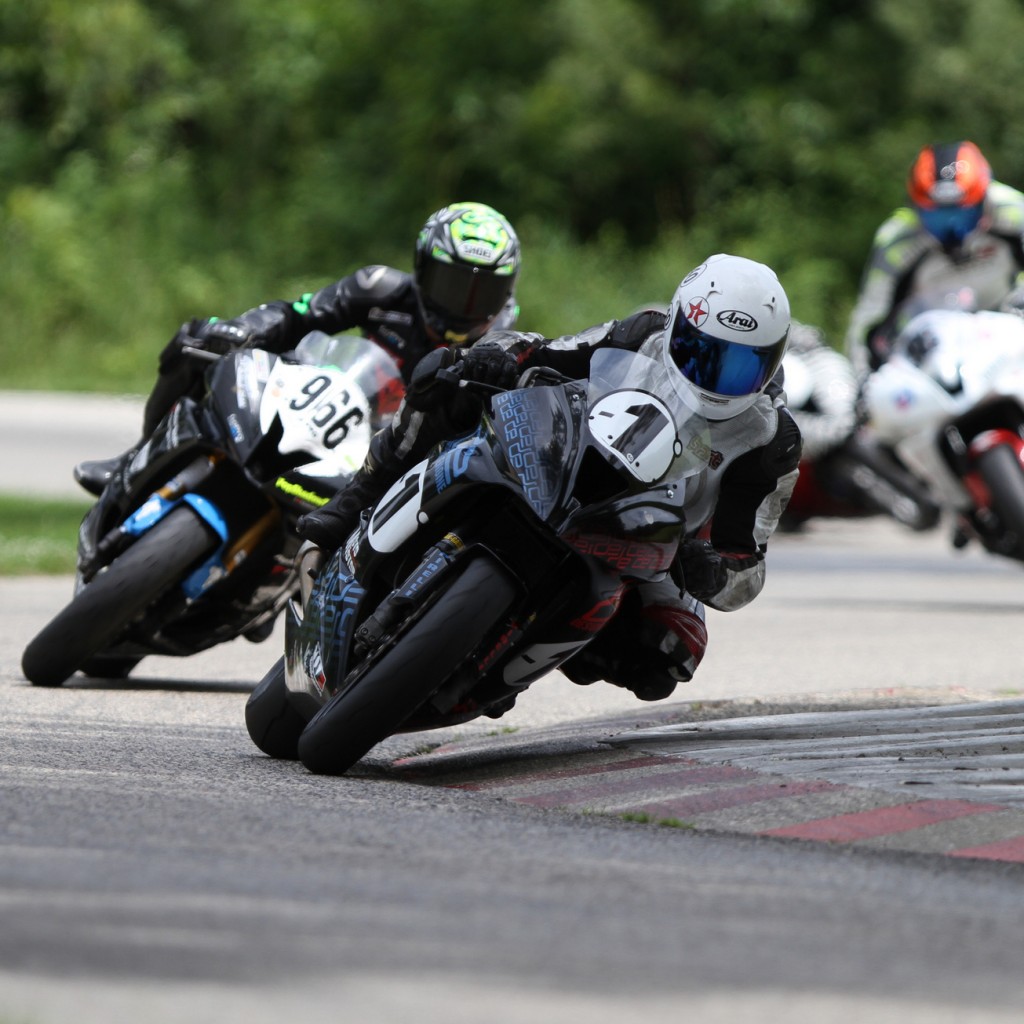At Design Engine, we are incredibly passionate about learning. We also love everything racing, whether it’s bicycles, motorcycles, rental cars, or even running up the stairs. Racing and learning have much in common because you learn so much each time you go out on the track. This is a lesson I was taught even as a kid when my dad showed me to reach back and grab the governor when racing go-carts. This showed me that even as a 65lb, 10-year-old kid, I could set the fastest lap time on the track.
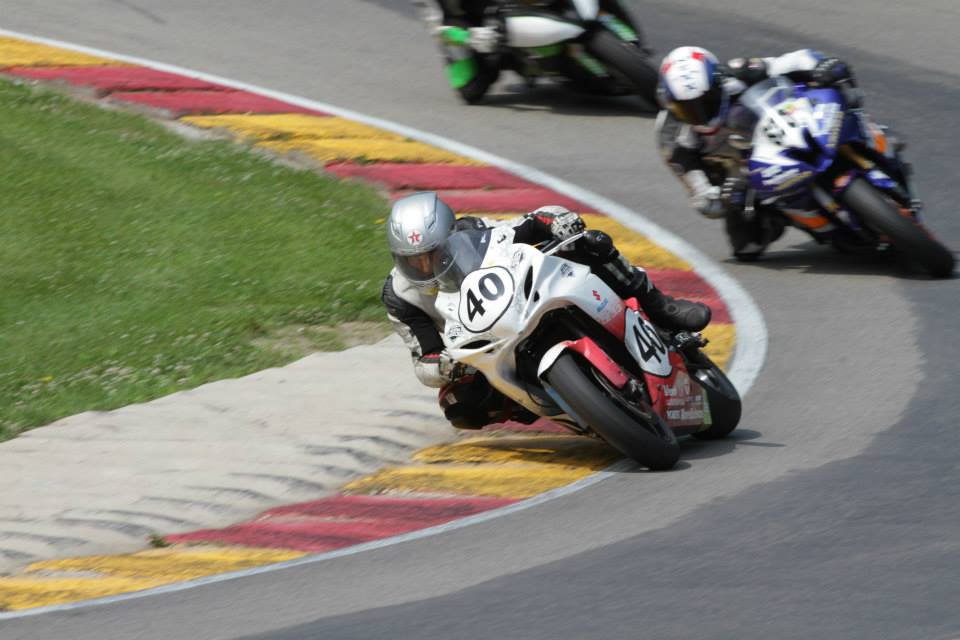
Bart Brejcha consistently hitting the same 3″ of track every lap
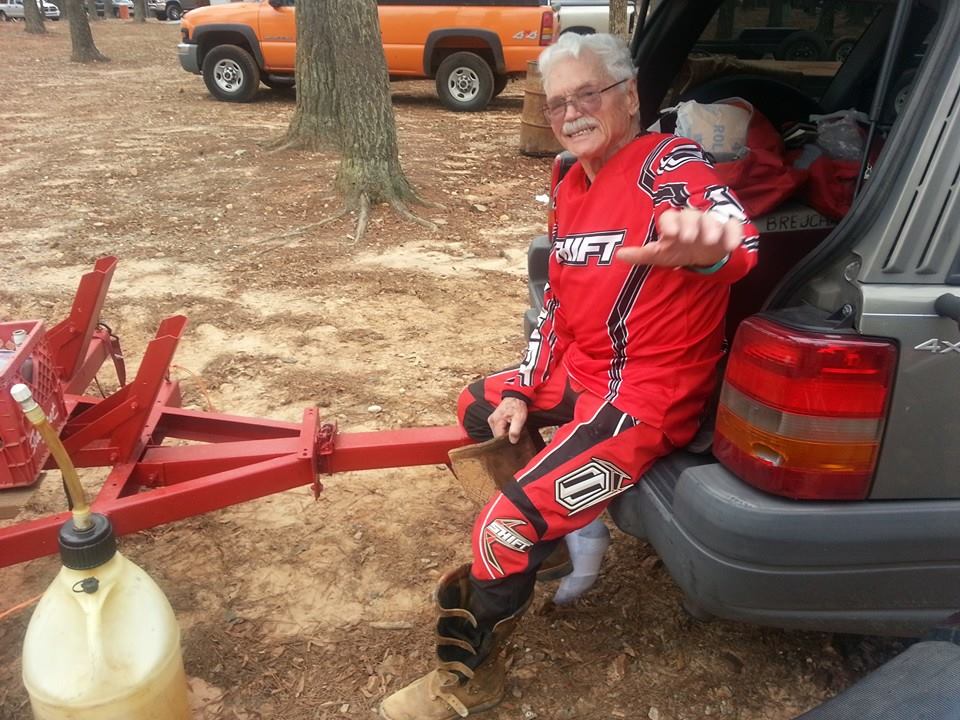
My dad Rollen at 80 years old after riding a full day motocross all day at Durhamtown Plantation in Middle GA
My dad raced motocross and enduros, so of course I also raced motocross as soon as I could ride a wheelie. Parents divorced, my mom could not tell us that racing was dangerous. Riding dirt bikes started as soon as 4yo. Growing up in a racing family, my dad and I raced everything from running to the mailbox to swimming the length of the pool, soon i was able to beat him on the dirt. Understand that my father was an engineer he created a mountain bike with rear suspension, complete with leather swing arms before bicycles were called mountain bikes circa 1974. Thirty years later, racing sportbikes was simply a natural next step where only attitude and money would hold me from giving it a try. Thanks to track days, I was able to ease into getting fast. Also, special thanks is due to NESBA and STT. I, Bart Brejcha, have compiled this list that has been explained to me by many people over the years.
After being asked what is one thing to do when you’re set on upgrading from trackdays and to go racing…. I rambled off off the top of my head starting with visualization then being coachable both as keys for success at the top of the list. As an engineering skills coach for many manufacturers and their designers and engineers, we must realize that there is never one item more important than any other. An engine can’t run without pistons. The truth is when you’re learning a new sport you going to struggle, it’s the passion for learning that is so addictive to me and being bad at something when you start is apart of my psyche. There is so much to learn with racing on track and off. This list is created in no particular order and developed simply for racing success. I’m not even sure if there are actually 100 items either as maybe you will count. You must realize that racing is a lifestyle and commitment and devotion of one’s self, family and friends, even though it’s just you racing it ends up still a team in the end. An odd perspective maybe, but racing is a sort of team sport. (use that in your next job interview) Let me tell you here what I’ve learned from others over the years racing all my life. Really all you have to do is 70 percent of this list to be a success. You don’t need a B-bike or extra wheels but watching others race videos or cleaning your brakes, for example as everything helps. Your toolbox builds up so you can have double tools in both trailer and garage over time. In the end, as many bones I have broken, I am in better shape than most 20 years my younger. But we must compare only to other racers not your neighbors.
Everyone even the fastest guys are on a budget so realize this list is made for everyone in mind to win consecutively. So take 70% of this list and give it your best effort. And is not meant to turn you off from racing, Its meant to give you a plan. it takes time and dedication and learning to get fast. Oh and If you want to add a bullet point to the list or a link, subtract or complain about my list (like the emotional beasts we are) email me bart@desingengine.com
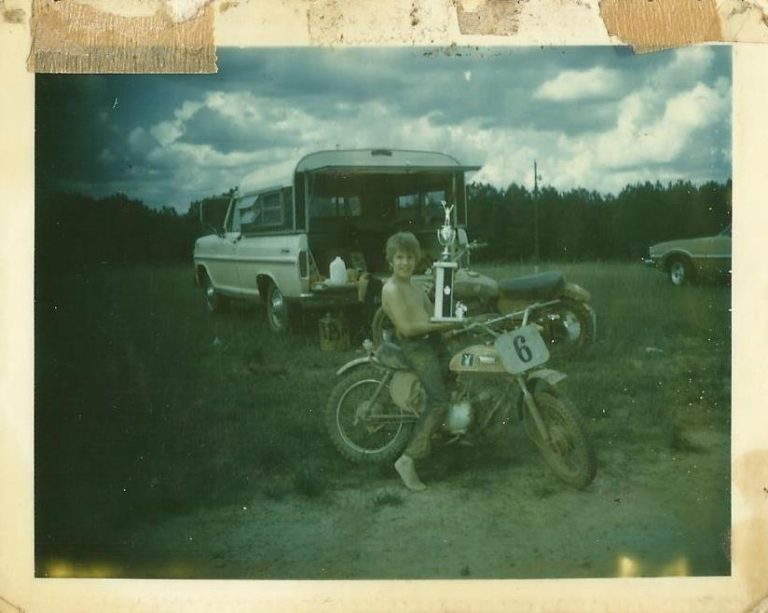
Bart's first trophy. Check out that ford and the playboy sticker
Tires
- Pick one brand of tires and stick with them. Switching around wastes time and creates confusion. Pirelli is probably the best choice at this time especially because they offer many various Shore durometers.
- Don’t store your tires in the sun. Typical tire dealers at the track will set tires out in the sun to sell them and be sure not to buy those specific tires. With those tires in the Sun off-gassing will occur and evaporate on the side where the tire is in the sun. I teach plastic design courses and many don’t realize the various plasticizers evaporate quickly in the sun drying your tires out where the sun hits the tire.
- Be careful handling tires that reach temperatures below freezing. They will crack or fracture if you handle them roughly. They will probably be just fine after getting up to temp after freezing. The problem is everything you do is with respect to confidence.
- Fluctuate tire inflation at various temperatures for experiments Come in hot and take the pressure reading. make notes and refer to those notes next time at the track. Track ambient temperature and pavement temperature in your notes.
- Consider using Nitrogen instead of atmospheric air. If using Nitrogen be more careful of the soap/lubricant used while mounting. The tire changer staff may not be aware that you are using nitrogen and be sloppy. H2O adds pressure with heat where Nitrogen does not. Also to note, observe your ties getting mounted (or have a team assistant watch the mounting process) if possible. All your confidence is felt through your feet to your brain from the tires. If you running nitrogen you don’t want any extra water or soap drainage. You will heat up, expand, and crash.
- Takeoffs are great for track days but you should be on race rubber for race practice.
- Learn to feel your ties slide especially the front. Of course, you feel the rear slide, the front slide is the next step and often where your limit is when pushing speed in the turns. Although compounds change the Dunlops for me offer a less noticeable ‘slide feel’ in the front. Confidence is everything for gaining speed.
- Always keep several sets of rain tires. When your tire dealers sell completely out you all set for multiple wins in the wet.
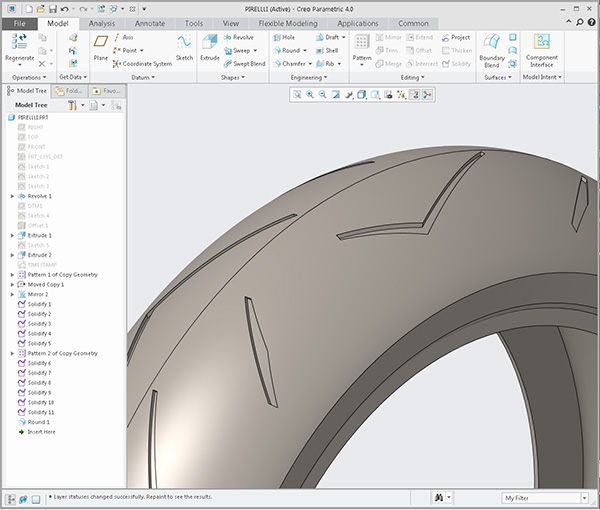
Pirelli Motorcycle tire modeled using PTC Creo Design software. This model uses surfaces to both cut the depth of the tread plus to mirror & pattern
Exercise/Rest/Injury
Lorem ipsum dolor sit amet, consectetur adipiscing elit. Ut elit tellus, luctus nec ullamcorper mattis, pulvinar dapibus leo.
- Hire a personal trainer (they work you harder than you would work yourself) Together you both create a workout program much more intense and ideal for motorcycle racing. Your personal trainer is going to learn too. Have them look at motocross workout videos. I am lucky my significant other is a personal trainer.
- Aggressive Ropework
- Do three 90 minutes of yoga per week or more. You simply crash better when you lose and are flexible.
- Run & bike. Sportbike racers tend to prefer mountain biking as an auxiliary sport because added obstacles in the woods help keep the mind occupied while continually pushing your aerobics.
- Work on your fitness of course, Yes. Don’t forget your hand health too! Good strong hands is one thing, calluses are terribly important for racers too. If you see a blister starting to form tape their hands like a boxer. I wrote this article on hand health for racers.
- Notice where your sore during racing and work on those weaknesses off track. Even Superheroes have weaknesses.
- Core Core Core – The body core is essential for motorbike racing. Squats, push-ups, pull-ups, sit-ups. Incline push-ups specifically with your feet up and chest down. One conversation I recall having with Jason Disalvo was to work on core.
- Educate your personal trainer by pointing out motocross workouts on YouTube so they can make you a training plan and help you stick to it.
- Don’t do sit-ups and count. Do them by the minutes. Consider listening to music for sit-ups. 3 or 4 songs of sit-ups in the morning for example.
- Motocross should be apart of your training regiment, especially for preparation against arm pump. If you get arm pump you’re both not in shape and or holding on too tightly.
- Sometimes you will end up working on one of your bikes all night long. Going out w/ sleep may be unavoidable at times however proper rest is imperative for winners
- Injury is a part of every athlete. Come to terms with injury and find ways to get around it. Racing w/ broken ribs for example.
- Eat Clean – Proper Nutrition is imperative for any athlete dieting with extreme exercise, vitamins, and even vitamin ‘I’.
- Vitamin ‘I’ or ibuprofen is imperative, especially as you age. Inflammation will dampen your workouts and your racing results. I won 5 championships at 50 years old.
- Consider a portable baby pool where if necessary you can add ice to water and sit in there to remove inflammation. Makes for great social media photos.

Bart Getting after it at Joliet MX
Attitude - Listen and Learn
- Be coachable – think about what that means to you and competitors that are not. Young people tend to be more coachable than older more set in their/your way of doing things version of yourself. Being open and coachable is a challenge as we age & gain more experience. The irony is someone else has to tell you the news that you are set in your ways. Listen to others’ advice. You don’t have to take the advice, however think thru the advice your getting.
- Ask questions but question everything.
- Don’t be the smartest person in the room. Real smart people realize they can learn from anyone and everyone.
- LLFF Attitude – Attitude goes so far! Listen – learn – fall – fall In the end, your attitude is how you will be remembered as you fail, fall or win.
- Have fun and get excited. Racing becomes work when you’re not having fun.
- Learn something every time you go out on the track. Have a plan and discuss what you’ve learned afterward with whomever will listen.
- Take classes from a track coach. Make sure the class is race-oriented. It will be the best money spent. Getting your race license does not count.
- If you crash another racer and it’s your fault and not just the ‘ASSFAULT’, offer to pay for some or all of their broken product. They may decline or accept and if it takes you a few months to pay out they can’t be too mad at you.
Racebikes/Prep (Only Money and Laziness Limit Us)
- Like repelling down a rock face. It is terrifying if you don’t trust in your equipment. Your equipment on course has to be in top condition for your trust and for this you forget things that might hold you back.
- Racebikes is plural. Have two bikes so you can so you don’t miss a race – For example you can cannibalize B-Bike if necessary.
- A Clean set of bikes is imperative. If you see oil you know it’s new because the bike was so clean before that the oil is new
- Ultrasonically clean your front brake calipers each race weekend
- Replace front rotors often (they warp with heat) I bent them back for a year and realized that does not work. Just buy new ones.
- Change your oil each race weekend. Since your changing oil so often consider using the lightest weight. In my Mark Junge built Vesrah Suzuki 600’s I used 0-5 weight oil. it counts for 3HP
- Update suspension with professional help & Clean suspension every 20 hrs I used Trackside Suspension Engineering http://tracksidesuspension.com/ and they are great and can often replace/clean your suspension at the track.
- Consider having help organizing your trailer. Draw out plans. Your accomplishments don’t have to be all at once.
- Do something significant each race weekend to your bike. Replacing to a race harness to adding fuel drainage, drill brake rotor buttons to lighten sprung and un-sprung components to push race rules. Everything helps. This becomes the fun part of racing that comes in your 3 or 4th year.
- Work with graphic designers: vinyl keeps your race plastic together and makes you faster. really. https://www.popshadowdecals.com/ Tea Palella has spent countless hours creating templates for every type of race plastic you could buy. Tea & Steve is awesome. I learned a lot from steve even though he never routed for my wins.
- Use engine builders and talk to them. They can tune the bike for your style. I prefer my power band at a more narrow band at higher revs.
- Track your bikes ‘on track time’ – 30 hrs is to much for a winner’s engine build and suspension cleaning.
- Have extra wheels mounted with tires all ready to go. Consider captive spacers faster wheel changes.
- Loose all the weight you can on your bike even your rear brake and reservoir. You only need the rear in the grass.
- Keep notes on sprocket use with respect to tracks. Realize your not at pace before lunch in race practice so if it feels your in the wrong gearing before lunch you may be correct but you could take more speed in later races. Get more speed in the turn and your gearing may be perfect.
On Course
- Don’t become set in your ways of doing things. This goes for everything in your life. Switching things up, practicing blocking lines for example everything can give you a strategic advantage.
- First time on the course take advantage of the first laps and go slow to observe. It’s your only excuse to go slow and see everything; See & Observe markers in the pavement, in the grass, curbs and places you don’t want to crash. Make those notes on your track map.
- Get off your bike on the slow laps to exaggerate your body position. A lower center of gravity offers a strategic advantage. Consider practicing your monkey moves as you hang off. It’s slower at first. Take one trackday and exaggerate that body position.
- Notice blemishes, crash points to avoid, brake markers, and other markers for yourself.
- Try to slide wheels everywhere: coming in and going out.
- Use the entire track (not just to do so as track day coaches preach) hard on the throttle requires the entire track. If your not taking the entire track you can take more speed next lap.
- Look through the turns
- Don’t look back when racing. Mount your camera in reverse if you must so you can watch it later. Your team will tell you how much your lead is.
- Many racers use earplugs. I personally need to hear if someone is behind me and they don’t work for me. If you have tinnitus it’s probably from not using ear protection in the dyno room.
- if you’re spinning too much you may not be taking enough corner speed. Get through there faster next lap. If your tires look bad after a session/race maybe your suspension is off yes, but it also may be you’re not taking enough corner speed. Try taking more corner speed first before adjusting your suspension.
- If you don’t crash sometimes you’re not trying hard enough.
- Chase people faster than you so they can pull you through the turns. Hopefully, you have the same or better grip but get that out of your head. Getting passed in a turn means you can go faster.
- Continually push your brake markers. Later races you should go way deeper. You can push brake marker #3 a Roebling Road’s T1 for example. Most people brake at #5. I don’t brake for T3 at Jennings.
- Concentrate on not over-breaking and braking with respect to taking more corner speed.
- Concentrate on getting smoothly on the throttle sooner.
- Concentrate on getting on the brakes more smoothly,. Also, consider Veserah brake pads.
- Pit with your suspension engineer or race coach or have a team. A team can help you concentrate on race craft.
- Gear your bike for being hard on the throttle before in the longest straight.
- Learn to leverage lapped riders effectively. It’s the opportunity created to get past the 1st place racers. It’s harder to manage lappers if you are in 1st but think of timing. If you can pick off one before the turn chances are that the 2nd place racer behind you will get held up in turn. Things get much more complicated when you come up on a bunch of lappers.

Research
- Take notes specific to course (date your notes and refer to them next time at that course)
- Watch race videos of the track no matter if you’ve never been there or are regularly race there or if they are your videos or belong to someone else.
- Note tire wear, ambient temperature, track temperature before and after lunch and add that information to your notes.
- Get track time before the race on the specific track you plan to race upon. Any track if that course is not possible. Look at google earth and consider drawing your track out beforehand.
- Try shit – Trying various ideas you have on your bike in your off race weekends or on track or during races is essential for gaining speed. “Go fast take chances” Experimentation is part of learning. not just on course. Take for example the idea of drilling out your front rotor buttons, for example, things like this truly make your brake floating. Or using a lithium battery pack instead of the stock lead battery.
- Learn who was at your race course the weeks before your race. Rubber laid down on course varies w/ cars and track management may not scrub the course properly.
- Walk or bike (bicycle) the course and look for debris like sand, dust, marbles. Upside down Miata’s leak oil and when it rains that oil floats on top of water and pavement on course. Ask during track/race meetings if the course was properly swept. Road America may not let you on track with a bicycle. Road Atlanta and smaller tracks will let you on course after hours.
Toolbox/Trailer/Spare Parts
- Have double tools for both garage and trailer. If you lose a tool cannibalize it from the garage box. (Takes time to accumulate this collection, don’t fret)
- In your toolbox, everything has a place. You can’t afford any moments looking for your 12mm socket. Consider cutting foam inserts so everything has a place and you know immediately if something is out of place.
- If you ever borrow a tool, purchase that tool on Monday for yourself.
- Organize trailer & consider spreadsheets and tag replacement parts. Everything in your trailer has a place. Each month update something in your trailer and update your spreadsheet as well.
- Order brake pads in bulk so you never run out update your spreadsheet after each race so you are aware of the spare quantity. Order extra lithium batteries often for your bike. Their life is short.
- Have plenty of new visors or shields for your helmet.
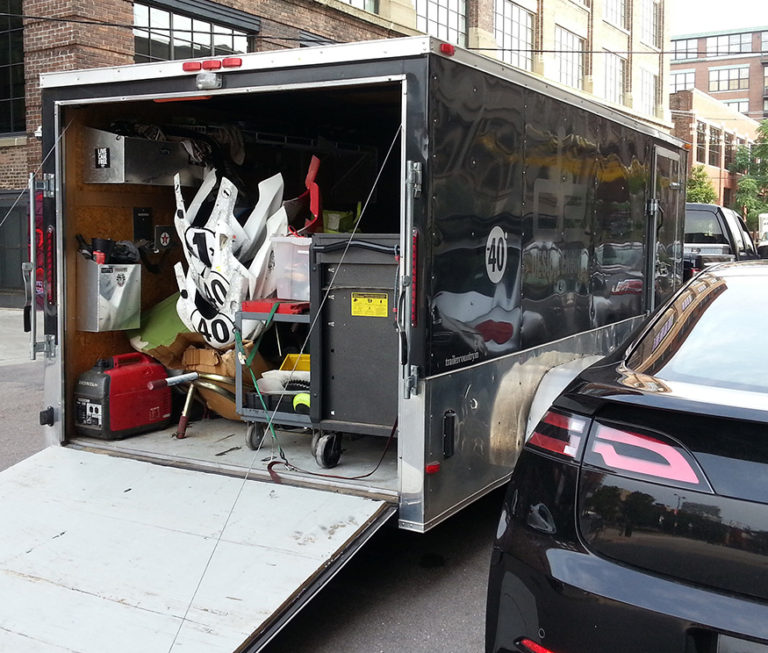
Design Engine trailer packed and loaded. I've never been known for my organizational skills. Everything has its place.
Visualization
- Visualization is almost equal to having track time. Use every tool available to yourself to pre or post visualization
- Draw the track out using pencil or Adobe Illustrator larger than google maps so you can draw on it. See the Illustrator track map below.
- Visualize the track of your next race when you wake up in the morning. Visualize your body position when you wake up in the morning thinking before you get out of bed. Do the same in your yoga sessions. When the yoga instructor tells you to flush everything out of your mind, go right to your next racecourse. Start on T7 and imagine in real-time going through the course. Racers don’t tend to have sleeping problems because they are so exhausted after each day. Train your brain to think in the morning if you don’t already. Don’t think about racing when you go to sleep you will never go to sleep. Do that thinking when you wake up.
Link to other Design Engine racing track maps HERE. https://design-engine.com/road-racing-track-maps/
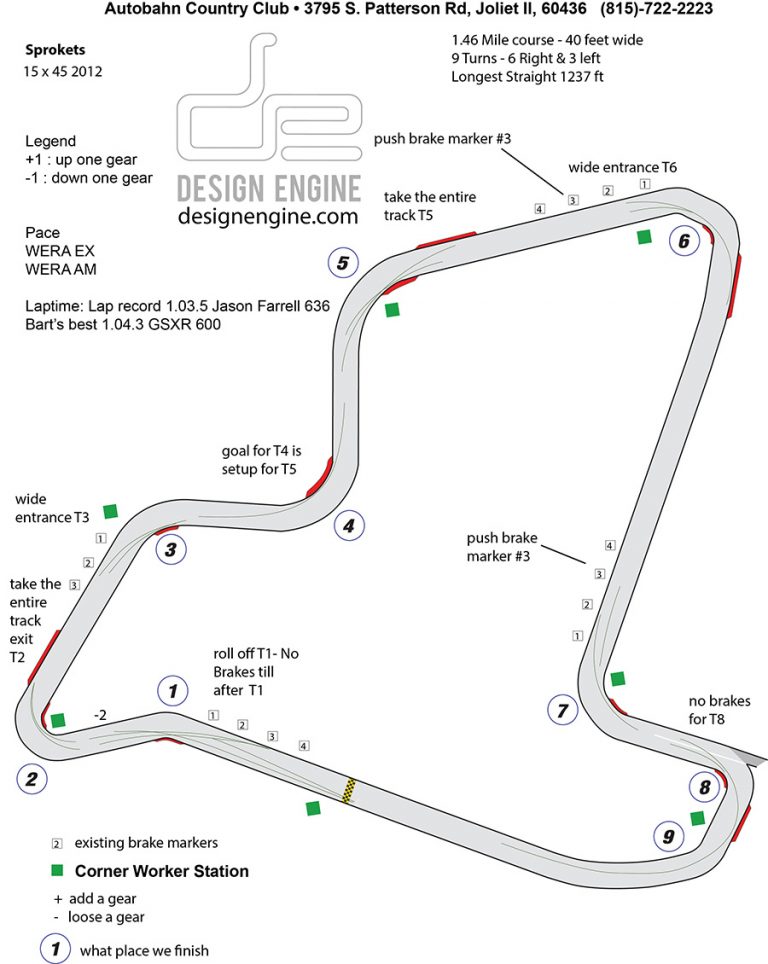
Autobahn North Course Track map
Track Time
- Get on course and get track time before a race weekend if possible. You need time on track before the race. Make note of all the blemishes on course and other break markers that may help your timing. See all the details.
- Winters are meant for Florida tracks like Jennings. Winters are goof for healing.
- Don’t coach track days it ill makes you slow. Advanced riders vs expert racers can be 5+ seconds per lap. You may get faster every year but lugging around on course is not how winners roll. (being vocal how I got into the head of fellow racers that coached track days)
- Organized track days – It’s not race practice…. though track days are great ways to get time on course you are not at pace because of traffic. Be careful of other advanced riders since they can spook easily. Realize if your race practicing, you may only practice one or two turns at speed because of traffic. Don’t get too frustrated.
- CCS is different from WERA when it comes to race practice. CCS mixes 1000cc with 600cc racers in race practice. In the turns, both have different speeds. If you’re on a 600 simply talk to a few of the 1000 guys at the riders meeting so they don’t pass you on straits for fun. Let them know if they pass you on a straight that you will pass them hard and fast on the inside of the next turn that they will pucker. If they forget they will not do it next time. You are practicing your corner speed and brake markers on race practice. WERA separates 600 from 1000 racers and that is a much safer and better overall experience for race practice. CCS take notice!
- If you are a fast amateur, offer to pay fast experts to coach you even if its a few laps. (they prob won’t take your money) But at least you can hang for a few laps as they pull you into more speed.
Quitters Don’t Last In Any Sport
- Surround yourself w/ positive reinforcement.
- Each year you gain experience and speed. If you quit you simply will not go faster. If you don’t quit you will be the fastest guy at the track.
Crashing
- The safest way to manage to crash is to plan to crash. In this way, you never skimp with safety equipment.
- If you don’t crash you’re not trying hard enough. Try to Slide & not tumble
- Safety First. If you crash you can’t miss the next race. Crashing is a necessary part of this sport prepare to crash which means safety equipment.
- Go fast take chances. Being Conservative does not win races.
- Make sure your folding levers fold the right way. Dragging plastic on coping is common. Don’t dig in w/ shifter or brake lever.
- Putting your arm out to break your fall you will break an arm or wrist.
- Folding your arms over your body during a fall is the safest crashing preparedness.
- You will break ribs. Unless you puncture lung ribs don’t count.
- Clavicles and fingers are the weakest parts of the human body. Usually, the helmet breaks the clavicle. Higher priced gloves protect hands better.
- Have plenty of stickers made by your graphic team in case you need to cover scratches in your helmet to pass tech. Extra new or un-crashed helmet is also necessary in case your helmet does not pass tech.
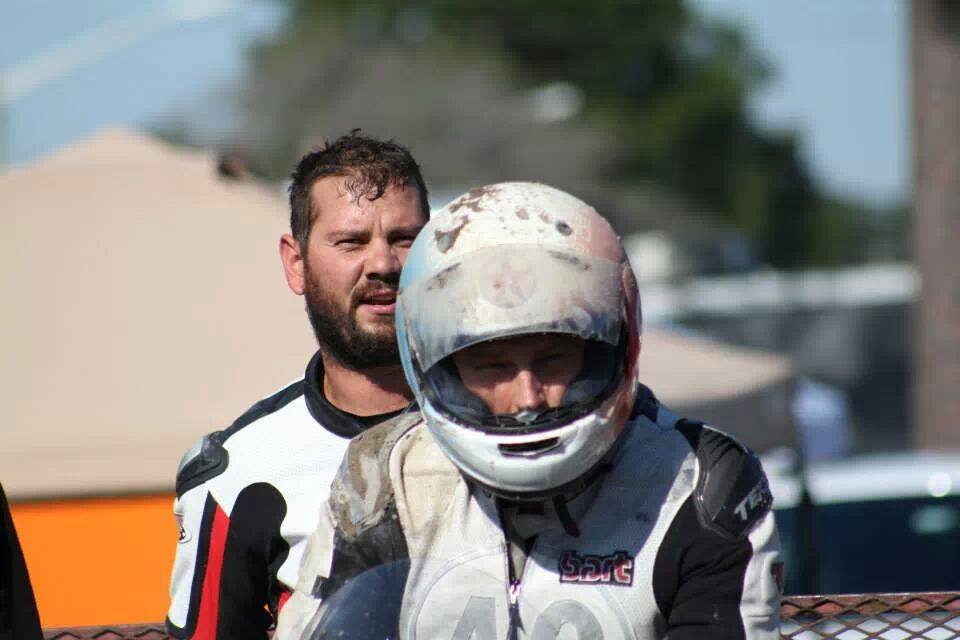
Bart Brejcha coming in with sand and mud after crashing in T4 at Roebling 2015 That's the late Christian Alvarado in the background.
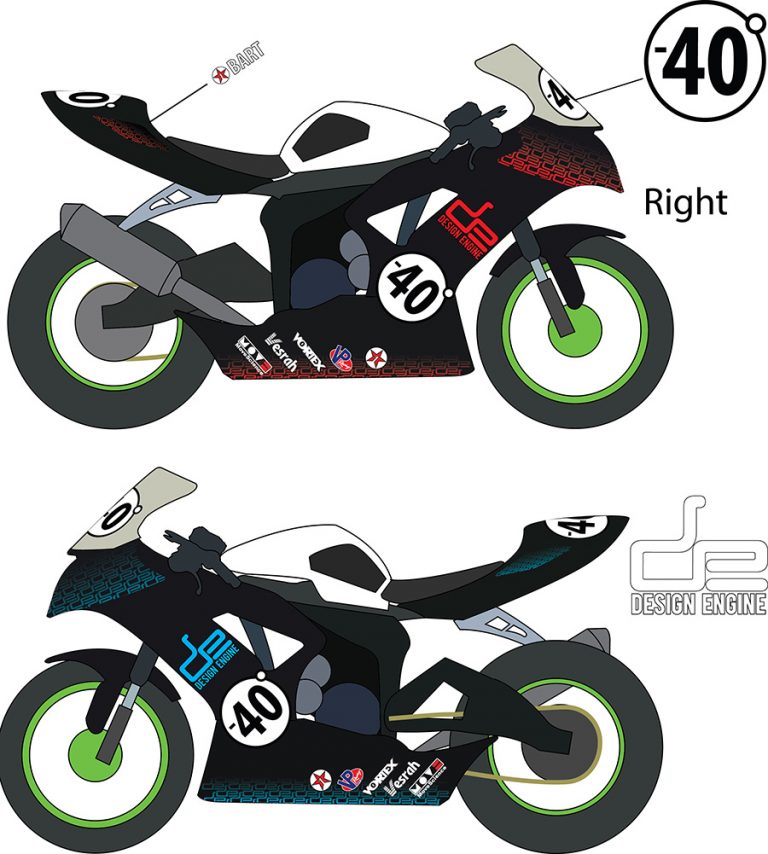
ZX6R Looks Like Model (thats what we call this illustrator file) created for the Kawasaki ZX6R The for print file is available upon request. At Design Engine we teach Adobe products. We have been talking about putting specific Adobe Illustrator training together a one week course on how to make your own graphics for compound surfaces.
If your interested contact us. Click here for link to the Design Engine erort wrapping the GSXR
Other
- Find your quirk – Valentino picks his seat going out on the track, some stretch – some meditate – some brush their teeth and all just before each race.
- Dry leathers out in between each race if possible. Sweat adds up and considers losing weight in this way. Big squirrel fan can be essential
- Consider two or more sets of race boots for wet races.
- Consider two sets of leathers for wet races or for more time to dry out between heat races.
- Loose weight – you can eat all the celery you can muster, never go for seconds and consider to drop alcohol. Physics … it takes longer to accelerate and de-accelerate with more weight.
- Long road trips require intermittent aerobic activity. Consider budgeting time for a hike or jogs or jump rope periods on longer road trips.
- Embrace change & continuously learn & set goals & talk about new ideas & accept responsibility
- Sooner than later you will think about going Professional. Realize this requires a picture oriented resume with an introduction, race results and what you expect to give as a deliverable to your sponsors. “Dads listen up”

Bart Brejcha's idea of taking it easy in one of the wet races. Notice the decals are all level when riding a wheelie. Having lots of stickers on hand help cover scratches on that helmet to pass tech.

Bart Brejcha getting out flanked by Jason Farrell on the first lap of an expert sportbike race near Chicago.

